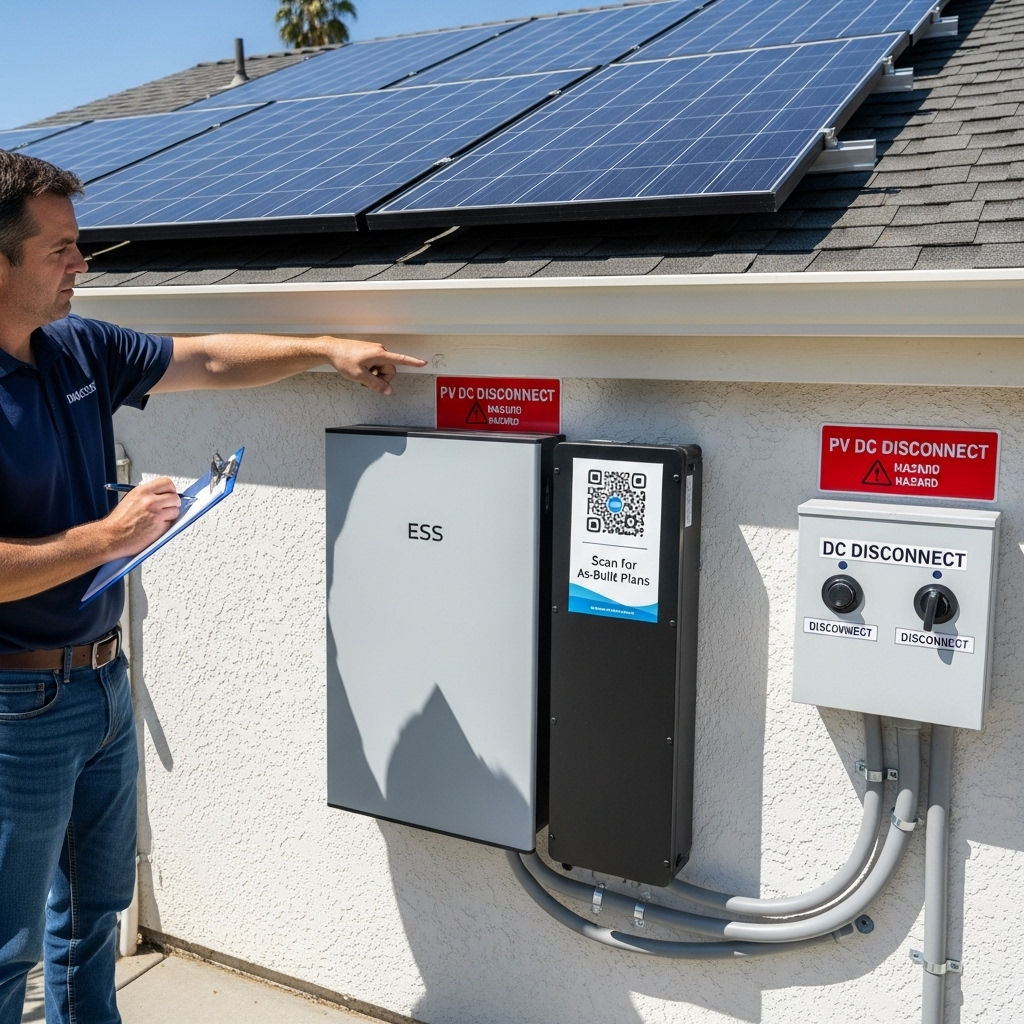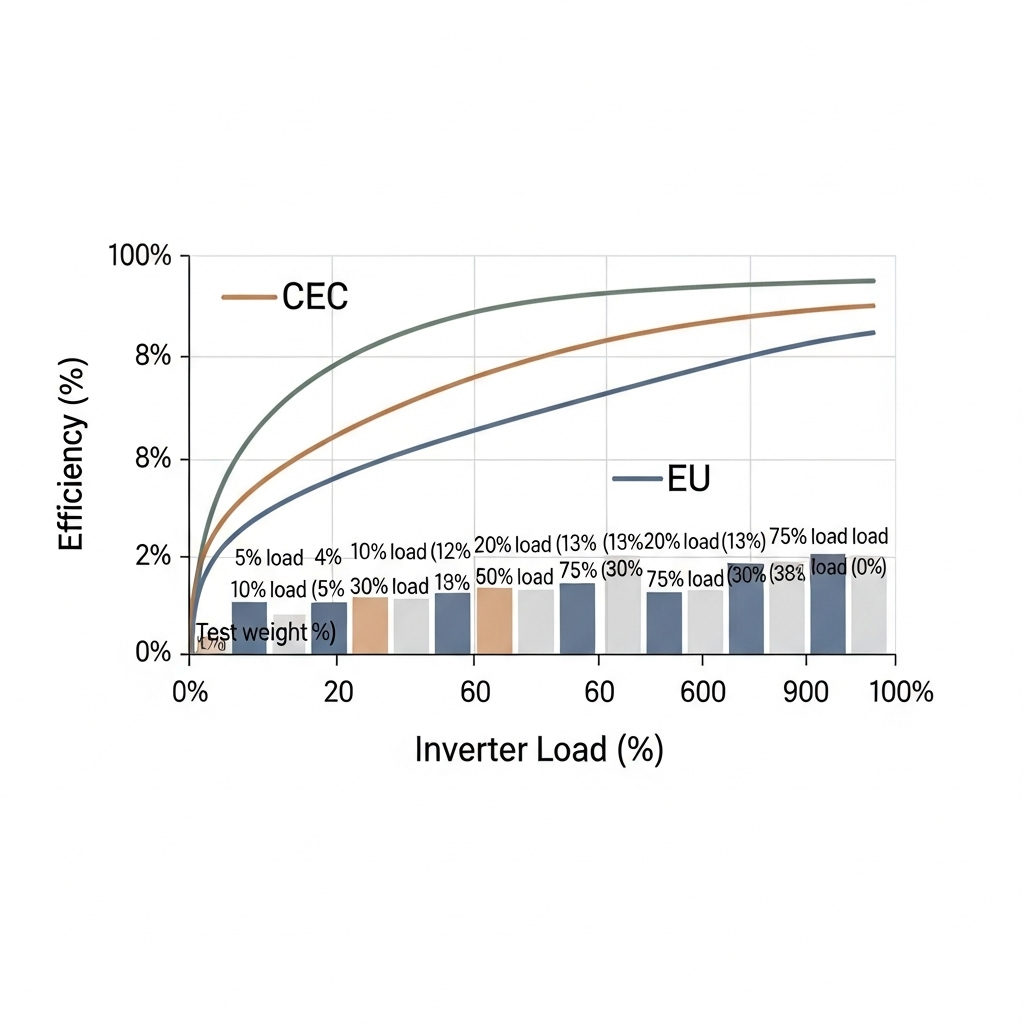Design teams face two different gatekeepers. IEC 62446-1 defines what to document and test for PV commissioning. NEC 690 dictates how to label and present safety information for code enforcement in the U.S. If you align both early, you reduce rework and speed acceptance. Non-legal, informational content only.

Scope at a glance
IEC 62446-1 focuses on system documentation and commissioning records
IEC 62446-1 specifies the minimum documentation for grid-connected PV systems. It also sets what to test during commissioning and what records to keep. Expect a complete single-line diagram, equipment datasheets, array layout, string-level test results, I-V curve evidence (for sampled strings), functional checks, and an O&M handover pack. The intent is repeatable quality and traceability across the system life.
For changes in module bill of materials or process, IEC TS 62915 outlines retesting and extension of type-qualification, which should be reflected in your project file. Certification context matters too. As noted by IRENA, IECEE offers CB and FCS schemes; FCS adds factory surveillance and is less common due to extra cost. These program choices influence the evidence stakeholders expect in your dossier.
NEC 690 centers on enforceable safety labeling and installation rules
NEC 690 is adopted by jurisdictions in the U.S. It is a mandatory electrical code once adopted by the Authority Having Jurisdiction (AHJ). It requires permanent, durable labels and directories for PV power sources, disconnecting means, rapid shutdown, and system output. You will see obligations such as PV DC power source marking (e.g., maximum voltage and current), AC output marking at the interactive inverter, identification of disconnects, and rapid shutdown signage (690.56(C)). Exact clause numbers and wording vary with code cycle; verify with your local AHJ.
Good practice is to prepare a label schedule and a system directory placard that references equipment names used in your drawings. Clear labels reduce field confusion and speed inspections.
Side-by-side: core documentation and labels
| Item | IEC 62446-1 | NEC 690 | Notes |
|---|---|---|---|
| Single-line diagram (SLD) | Required with component ratings and protection | Not prescribed as a standard, but often requested by AHJ/utility | Use consistent equipment tags across SLD and labels |
| Array layout and string map | Required | Not required | Supports troubleshooting and I-V sampling plan |
| Equipment datasheets | Required | Sometimes requested | Keep PV modules, inverters, combiner boxes, and RSD devices |
| Commissioning test records | Required | Not specified | Include polarity, Voc/Isc vs expected, insulation resistance, functional checks |
| I-V curve traces (sampled) | Recommended/used frequently | Not required | Attach to acceptance dossier for trending |
| Operation & maintenance pack | Required | Not required | Include maintenance schedule and contact details |
| PV DC power source label | Not specified | Required | Include max voltage/current and conductors |
| AC output rating label | Not specified | Required | At point of interconnection or inverter output (690.54) |
| Disconnect identification | Not specified | Required | Mark DC and AC disconnects; ensure permanence |
| Rapid shutdown signage | Not specified | Required | Per 690.56(C) for buildings with RSD |
| Conductor identification | Not specified | Required | Per wiring and identification rules in 690.31 |
Build a package that satisfies both
1) Start with an IEC 62446-1 commissioning folder
- SLD with protective devices, conductor sizes, fault-current and voltage limits.
- Array layout and string map tied to equipment tags.
- Datasheets and certificates for PV modules and inverters. Keep IECEE CB reports if available; this aligns with IRENA quality infrastructure practices.
- Test records: open-circuit voltage and short-circuit current vs expected values (irradiance/temperature corrected), insulation resistance to earth, polarity, functional checks, and I-V curves for sampled strings.
Typical acceptance bands used in field practice (not a standard requirement) are shown below. Always align with manufacturer guidance and project specifications.
| Test | Typical field acceptance band | Comment |
|---|---|---|
| Voc (string) | Within ±5–10% of corrected prediction | Use site irradiance/temperature for correction |
| Isc (string) | Within ±5–10% of corrected prediction | Check for shading and wiring resistance |
| Insulation resistance | Meets manufacturer and local rules | Record test voltage and measured megaohms |
2) Add a NEC 690 label schedule and placements
- PV DC power source label at combiner or DC disconnect showing maximum voltage, current, and wiring details.
- AC output rating label at the interactive inverter or service equipment with nominal voltage and maximum current.
- Disconnect labels for DC and AC isolators with clear identification.
- Rapid shutdown signage at the service disconnect per 690.56(C), with the correct diagram/wording for your rapid shutdown type.
- System directory placard identifying all disconnects and equipment locations using the same tags as your drawings.
For utility-interactive systems, align with interconnection notes and any local amendments. For broader PV safety context, see U.S. DOE resources.
Real project patterns
Residential roof, string inverter with RSD
- IEC: Keep string map, inverter datasheet, RSD device datasheets, commissioning checks with select I-V curves. Store weather data alongside test results.
- NEC: Apply rapid shutdown signage at the service equipment, PV DC power source label, and disconnect markers. Add an AC output label at the inverter output or service point.
C&I rooftop with combiner boxes
- IEC: Include combiner schedules, protective device settings, and a sampling plan for I-V measurements at the combiner level.
- NEC: Provide durable placards near roof access showing equipment locations. Use conductor identification per 690.31 and clearly mark multiple DC disconnects.
Off-grid or hybrid with ESS
Hybrid systems benefit from performance disclosures in the documentation set. The Ultimate Reference to Solar Storage Performance summarizes practical metrics to include, such as round-trip efficiency, cycle life at stated depth-of-discharge, charge/discharge C-rates, and temperature derating notes. Many LiFePO4 systems show round-trip efficiency near the low-90% range and multi-thousand-cycle life under moderate DoD, which helps set realistic O&M expectations as part of the handover pack. Align labeling with NEC 690 on the PV side and with applicable storage sections adopted by your AHJ for the ESS side.
Why strong records and clear labels reduce soft costs
Transparent documentation lowers friction across the value chain. IEA emphasizes process quality and data visibility as enablers for integration at scale. Early definition of documentation and labels minimizes redesign and inspection repeats.
Historic IEA work on PV market development notes that consistent technical files improve bankability and deployment confidence (Technology Roadmap — Solar PV Energy). For operations, clear labeling and accurate directories support safe intervention, which ties to reliability themes in Next-Generation Wind and Solar Power.
National data sources like the EIA reflect steady PV growth. As volume rises, even small gains in first-pass inspection approvals can cut schedule risk across many sites.
Quality and certification context you can reference
Documenting product conformity helps downstream stakeholders. As summarized by IRENA, IECEE’s CB scheme is a common market baseline for PV components. The FCS option adds factory surveillance. When BoM or process changes occur, keep traceable evidence and update your site file, aligned with retest guidance like IEC TS 62915. For module field diagnostics, IEC 62446-4 describes outdoor electroluminescence imaging that can reveal latent defects; include such reports where used.
Action checklist
- Create a two-part package: IEC 62446-1 commissioning folder + NEC 690 label schedule.
- Use the same equipment tags on drawings, test sheets, and labels.
- Attach weather-corrected calculations to each Voc/Isc record. Archive I-V curves.
- Print durable placards. Confirm wording and colors per local code cycle.
- For hybrid systems, add storage performance notes and link to an index page (QR). Consider metrics outlined in the storage performance reference.
Compliance note: Codes vary by jurisdiction and adoption year. Always confirm with your AHJ and utility. This is not legal advice.
FAQ
Do IEC 62446-1 records replace NEC 690 labels in the U.S.?
No. IEC 62446-1 governs commissioning documentation and tests. NEC 690 governs code-enforceable labels and installation rules in the U.S. Most AHJs expect both: solid test records and correct labels.
Can I use QR codes for NEC 690 labeling?
You can add QR codes to link drawings and manuals. But the physical label text must still meet NEC requirements for permanence, format, and visibility. Treat QR codes as a supplement.
What should be in my IEC 62446-1 test pack?
Include a single-line diagram, array map, datasheets, polarity checks, Voc/Isc vs corrected predictions, insulation resistance, functional checks, and sampled I-V curves. Note the test instruments and calibration dates.
How do I reflect product changes after commissioning?
Update your site file with new datasheets, revised SLDs, and any retest evidence. IEC TS 62915 offers retest guidance when materials or process change. Keep a change log in the O&M pack.
Where can I cite performance metrics for storage in my handover pack?
Use a concise sheet with round-trip efficiency, cycle life at stated DoD, C-rates, and temperature limits. The Ultimate Reference to Solar Storage Performance collects those metrics and context you can cite in your pack.





Leave a comment
All comments are moderated before being published.
This site is protected by hCaptcha and the hCaptcha Privacy Policy and Terms of Service apply.